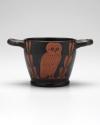Drinking Cup with the Owl of Athena
Drinking Cup with the Owl of Athena
Artistattributed to
Unidentified Hanau Group
(Greek or Etruscan)
Period
Early Etruscan
(Etruscan, 9th century-4th century BCE)
Place of OriginItaly, Apulia
Date425-400 BCE
Dimensionsto top of handles: 3 7/8 in. (9.8 cm)
to rim: 3 13/16 in. (9.7 cm)
with handles: 7 1/4 in. (18.5 cm)
4 1/2 × 3 3/8 in. (11.5 × 8.5 cm)
to rim: 3 13/16 in. (9.7 cm)
with handles: 7 1/4 in. (18.5 cm)
4 1/2 × 3 3/8 in. (11.5 × 8.5 cm)
MediumEarthenware, wheel-thrown, with black slip and added red slip decoration.
ClassificationCeramics
Credit LineGift of Edward Drummond Libbey
Object number
1912.1226
Not on View
DescriptionThis object is a wheel-thrown ceramic drinking cup known as a glaux or skyphos of Type B. It has a deep bowl, a low torus foot, and two horizontal, slightly upturned handles. The entire vessel is coated in a black slip. The decoration is identical on both sides: an owl with its body in profile to the right and its head turned to face front, flanked by two vertical olive sprays. The technique is "added red," where the red-orange color of the figures was painted over the black background slip. Finer details, such as the owl's facial features, wing feathers, and the spines of the olive leaves, were then added in black paint on top of the red areas. The interior is fully glazed. The underside of the foot is reserved and features a black circle and dot at the center.
Label TextThis drinking cup, or skyphos, was designed to look like a classic souvenir from ancient Athens. It features the city's famous emblem: the owl of Athena, goddess of wisdom, flanked by her sacred olive sprigs. In the late 5th century B.C., cups with this design were wildly popular exports, broadcasting Athenian cultural prestige across the Mediterranean. This cup, however, is a clever imitation with a technical secret. An Athenian potter would have painstakingly painted the black background around the owl, leaving its shape in the natural red clay. This artist used a shortcut, painting the entire cup black and then applying the owl's red-orange color on top. This "added red" technique was a hallmark of workshops imitating Athenian wares, creating a fascinating "whodunit" for scholars. Was it made by the Etruscans in central Italy, who were known for this method? Or was it made by Greek colonists in Apulia (southern Italy)? Both were competing to produce their own versions of the fashionable "Athenian" brand. While experts have debated the evidence for decades, the museum’s current research attributes this skyphos to an Apulian workshop, a testament to the far-reaching influence of Athenian culture.Published ReferencesWashington, S., "Greek Vase Painting," Toledo Museum of Art Museum News, vol. 5, no. 4, 1962, p. 93, repr.
Luckner, Kurt T., "Greek Vases: Shapes and Uses," Toledo Museum of Art Museum News, vol. 15, no. 3, p. 78, fig. 24.
Boulter, Cedric G., and Kurt T. Luckner, Corpus Vasorum Antiquorum, Toledo Museum of Art, fasc. 2, U.S.A., fasc. 20, Mainz, 1984, pl. 94, 1, p. 18.
Comparative ReferencesSee also Beazley, J.D., Etruscan Vase-Painting, Oxford, 1947, pp. 111-112 (for a discussion of the Hanau Group, to which this vase has been related).The Acheloos Painter, Leagros Group
about 510-500 BCE
about 575 BCE
about 330-320 BCE
6th century BCE

Membership
Become a TMA member today
Support TMA
Help support the TMA mission
















